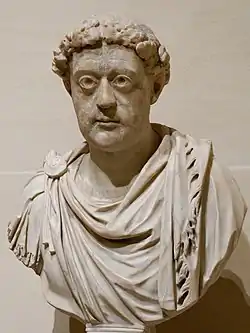457
Year 457 (CDLVII) was a common year starting on Tuesday (link will display the full calendar) of the Julian calendar. At the time, it was known as the Year of the Consulship of Constantinus and Rufus[1] (or, less frequently, year 1210 Ab urbe condita). The denomination 457 for this year has been used since the early medieval period, when the Anno Domini calendar era became the prevalent method in Europe for naming years.
| Millennium: | 1st millennium |
|---|---|
| Centuries: | |
| Decades: | |
| Years: |
| 457 by topic |
|---|
| Leaders |
|
| Categories |
|
| Gregorian calendar | 457 CDLVII |
| Ab urbe condita | 1210 |
| Assyrian calendar | 5207 |
| Balinese saka calendar | 378–379 |
| Bengali calendar | −136 |
| Berber calendar | 1407 |
| Buddhist calendar | 1001 |
| Burmese calendar | −181 |
| Byzantine calendar | 5965–5966 |
| Chinese calendar | 丙申年 (Fire Monkey) 3153 or 3093 — to — 丁酉年 (Fire Rooster) 3154 or 3094 |
| Coptic calendar | 173–174 |
| Discordian calendar | 1623 |
| Ethiopian calendar | 449–450 |
| Hebrew calendar | 4217–4218 |
| Hindu calendars | |
| - Vikram Samvat | 513–514 |
| - Shaka Samvat | 378–379 |
| - Kali Yuga | 3557–3558 |
| Holocene calendar | 10457 |
| Iranian calendar | 165 BP – 164 BP |
| Islamic calendar | 170 BH – 169 BH |
| Javanese calendar | 342–343 |
| Julian calendar | 457 CDLVII |
| Korean calendar | 2790 |
| Minguo calendar | 1455 before ROC 民前1455年 |
| Nanakshahi calendar | −1011 |
| Seleucid era | 768/769 AG |
| Thai solar calendar | 999–1000 |
| Tibetan calendar | 阳火猴年 (male Fire-Monkey) 583 or 202 or −570 — to — 阴火鸡年 (female Fire-Rooster) 584 or 203 or −569 |

Emperor Leo I (457–474)
Events
Roman Empire
- January 27 – Emperor Marcian dies at Constantinople, possibly of foot gangrene, an infection contracted during a long religious journey. He is buried in the Church of the Holy Apostles, together with his late wife Pulcheria.[2][3]
- February 7 – Leo I, a Thraco-Roman (or Dacian) high-ranking officer, becomes the new emperor of the Eastern Roman Empire, reigning for nearly 20 years. He is first to accept the Byzantine crown from the hands of the patriarch of Constantinople.[4][5]
- April 1 – Majorian is acclaimed emperor by the Roman army, after defeating 900 Alemanni near Lake Maggiore (Italy).[6][7]
- December 28 – Majorian is crowned emperor of the Western Roman Empire and recognized by Pope Leo I. His rule is accepted in Italy, Dalmatia and some territories in Northern Gaul.[8]
Europe
- Childeric I succeeds his father Merovech as king of the Salian Franks. He establishes his capital at Tournai (modern Belgium) and becomes a foederatus (pl. foederati) of the Western Roman Empire.
- According to the Anglo-Saxon Chronicle, 4,000 Britons are slain at Crecganford in battle against Hengist and his son Oisc of Kent.[9]
Persia
Births
Deaths
- January 27 – Flavius Marcian, Roman emperor (b. 392)[2]
- October 28 – Ibas, bishop of Edessa (modern Turkey)
- Avitus, emperor of the Western Roman Empire
- Merovech, king of the Salian Franks (approximate date)
- Palladius, first bishop of Ireland (approximate date)
- Saint Proterius, Patriarch of Alexandria
- Theodoret of Cyrrhus, bishop and theologian
- Valerian of Abbenza, bishop and saint (b. 377)
- Yazdegerd II, king of the Persian Empire[10]
References
- School of Irish Learning (Dublin) (1907). "The Exordium of the 'Annales Cambriae'". Eriu : the journal of the School of Irish Learning, devoted to Irish philology and literature. Royal Irish Academy. p. 122. OCLC 612608668.
- Croke, Brian (1978). "The date and circumstances of Marcian's decease". Byzantion. 48: 5–9. JSTOR 44170550.
- Nathan, Geoffrey S. (1998). "Roman Emperors – DIR Marcian". www.roman-emperors.org. Archived from the original on July 6, 2018. Retrieved August 4, 2018.
- Bury, John Bagnell (1958). History of the Later Roman Empire: from the death of Theodosius I to the death of Justinian. Dover books. Vol. 1. Dover Publications. ISBN 978-0-486-20398-0.
- Edward Gibbon, The Decline and Fall of the Roman Empire, Volume I, Chap. XXXVI (Chicago: Encyclopædia Britannica, Inc., 1952), p. 582. Bibl. Theophanes, p. 95 [ed. Par.; tom. i p. 170, ed. Bonn].
- Sidonius Apollinaris, Carmina, V.373–385.
- Fasti vindobonenses priores, 583.
- Timothy Barnes, "Review: Late Roman Prosopography: Between Theodosius and Justinian", Phoenix, vol. 37, no. 3 (1983), pp. 268–269
- Brayley, Edward Wedlake (1808). The Beauties of England and Wales; or, Original Delineations Topographical, Historical and Descriptive of Each Country. Vol.VII. London: Thomas Maiden Sherbourn-Lane. p. 416. Retrieved March 9, 2019.
- Pourshariati, Parvaneh (2008). Decline and Fall of the Sasanian Empire: The Sasanian-Parthian Confederacy and the Arab Conquest of Iran. London and New York: I.B. Tauris. p. 70. ISBN 978-1-84511-645-3.
- Shahbazi, A. Shapur (2004). "Hormozd III". In Yarshater, Ehsan (ed.). Encyclopædia Iranica, Volume XII/5: Homosexuality III–Human migration II. London and New York: Routledge & Kegan Paul. pp. 465–466. ISBN 978-0-933273-79-5.
- Bonner, Michael (2020). The Last Empire of Iran. New York: Gorgias Press. p. 124. doi:10.31826/9781463240516. ISBN 978-1-4632-0616-1. S2CID 219805346.
- Blackburn, Bonnie J.; Holford-Strevens, Leofranc (1999). The Oxford Companion to the Year. Oxford University Press. p. 793. ISBN 978-0-19-214231-3.
This article is issued from Wikipedia. The text is licensed under Creative Commons - Attribution - Sharealike. Additional terms may apply for the media files.